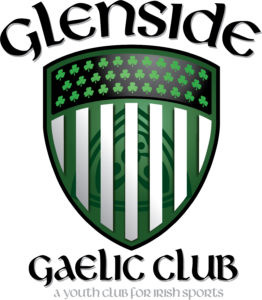About Gaelic Football
Gaelic football is for boys and girls and it combines the footwork and endurance of soccer, the jumping and hand skills of basketball and the kicking and tactical awareness of rugby in a field sport that is high scoring and entertaining. Commonly referred to as football or Gaelic, it is a sport played between two teams consisting of between 7 and 15 players on a rectangular grass pitch. The objective of the sport is to score points by passing the ball through the other team’s goals, a set of two upright posts separated by a crossbar 8.2 ft. (2.5 meters) above the ground.
Players advance the football, a spherical leather ball, up the field with a combination of carrying, bouncing, kicking, hand-passing, and soloing (dropping the ball and then toe-kicking the ball upward into the hands). In the game, two types of scores are possible: points and goals. A point is awarded for kicking or hand-passing the ball over the crossbar, signaled by the umpire raising a white flag. A goal is awarded for kicking the ball under the crossbar into the net, signaled by the umpire raising a green flag. Positions in Gaelic football are similar to that in other football codes, and comprise one goalkeeper, six backs, two midfielders, and six forwards, with a variable number of substitutes.
The sport, a form of football derived from traditional Irish ball games, is mainly played in the country of Ireland, although associations exist in other areas such as Great Britain and North America. Gaelic football is one of four sports (collectively referred to as the “Gaelic games”) controlled by the Gaelic Athletic Association (GAA), the largest sporting organization in Ireland. Along with hurling and camogie, Gaelic football is one of the few remaining strictly amateur sports in the world, with players, coaches, and managers prohibited from receiving any form of payment.
Gaelic football is the most popular sport in Ireland in terms of attendance, with the 2011 All-Ireland Senior Championship Final, held at Croke Park, Dublin, drawing an attendance of 82,300 people. Outside of Ireland, football is mainly played amongst members of the Irish diaspora. Gaelic Park in New York City is the largest purpose-built Gaelic sports venue outside of Ireland. Three major football competitions operate throughout the year: the National Football League and the All-Ireland Senior Championship are operated on a county basis, while the All-Ireland Club Championship is contested by individual clubs. The All-Ireland Senior Championship is run as a knock-out competition, with the top two counties meeting in the All-Ireland Football Final, considered the most prestigious event in Gaelic football.
Rules of Gaelic Football
Playing field:
A Gaelic pitch is similar in some respects to a rugby pitch but larger. The grass pitch is rectangular, stretching 130–145 meters long and 80–90 meters wide. There are H-shaped goalposts at each end, formed by two posts, which are usually 7 meters high, set 6.5 meters apart, and connected 2.5 meters above the ground by a crossbar. A net extending behind the goal is attached to the crossbar and lower goal posts. The same pitch is used for hurling; the GAA, which organizes both sports, decided this to facilitate dual usage. Lines are marked at distances of 13 meters, 20 meters and 45 meters from each end-line. Shorter pitches and smaller goals are used by youth teams.[6]
Duration:
The majority of adult football and all minor and under-21 matches last for 60 minutes, divided into two halves of 30 minutes, with the exception of senior inter-county games which last for 70 minutes (two halves of 35 minutes). Draws are decided by replays or by playing 20 minutes of extra time (two halves of 10 minutes). The under-12s have a half of 20 minutes or 25 minutes in some cases. Half-time lasts for about 15 minutes.
Teams:
Teams consist of between seven and fifteen players (a goalkeeper, two corner backs, a full back, two wing backs, a center back, two mid fielders, two wing forwards, a center forward, two corner forwards and a full forward) plus up to fifteen substitutes, of which five may be used. Each player is numbered 1–15, starting with the goalkeeper, who must wear a jersey color different from that of his or her teammates. Up to fifteen substitutes may be named on the team sheet, number 16 usually being the reserve goalkeeper.
Ball:
The game is played with a round leather football made of 18 stitched leather panels, similar in appearance to a traditional volleyball, with a circumference of 69–74 cm (27–29 in), weighing between 370–425 g (13–15.0 oz) when dry. It may be kicked or hand passed. A hand pass is not a punch but rather a strike of the ball with the side of the closed fist, using the knuckle of the thumb.
Technical fouls:
The following are considered technical fouls (“fouling the ball”):
- Bouncing the ball twice in a row (It may be soloed continuously). Changing hands: Throwing the ball from your right-hand to left or vice-versa (legal in the ladies’ game)
- Going four steps without releasing, bouncing or soloing the ball (soloing involves kicking the ball into one’s own hands)
- Hand passing a goal. To hand pass a ball with an open palm there must be a clear striking action (the ball may be punched over the bar from up in the air, but not into the goal).
- Picking the ball directly off the ground (it must be scooped up into the hands by the foot). However in ladies’ Gaelic football the ball may be picked up directly.
- Square ball is an often controversial rule: If, at the moment the ball enters the small square, there is already an attacking player inside the small rectangle, then a free out is awarded. As of 2012 square balls are only counted if the player is inside the square when the ball is kicked from a free or set piece. An opposing player is allowed in the square during open play.
- Throwing the ball (it may be “hand-passed” by striking with the fist).
Scoring:
If the ball goes over the crossbar, a point is scored and a white flag is raised by an umpire. A point is scored by either kicking the ball over the crossbar, or fisting it over, in which case the hand must be closed whilst striking the ball. If the ball goes below the crossbar, a goal, worth three points, is scored, and a green flag is raised by an umpire. A goal is scored by kicking the ball into the net, not by fist passing the ball into it. However, a player can strike the ball into the net with a closed fist if the ball was played to him by another player or came in contact with the post/crossbar/ground prior to connection. The goal is guarded by a goalkeeper. Scores are recorded in the format Goal Total-Point Total. To determine the score-line goals must be converted to points and added to the other points. For example, in a match with a final score of Team A 0–21 Team B 4–8, Team A is the winner with 21 points, as Team B scored only 20 points (4 times 3, plus 8).
Defending:
The level of defending allowed is more robust than in soccer, but much less than rugby.
Shoulder to shoulder contact and slapping the ball out of an opponent’s hand are permitted, but the following are all fouls:
- Blocking a shot with the foot
- Pulling an opponent’s jersey
- Pushing an opponent
- Sliding tackles
- Striking an opponent
- Touching the goalkeeper when he/she is inside the small rectangle
- Tripping
- Using both hands to tackle
- Wrestling the ball from an opponent’s hands
Restarting play:
A match begins with the referee throwing the ball up between the four mid fielders.
After an attacker has put the ball wide of the goals, scored a point or a goal, the goalkeeper may take a kick out from the ground at the 13m line. All players must be beyond the 20m line.
After a defender has put the ball wide of the goals, an attacker may take a “45″ from the ground on the 45m line, level with where the ball went wide.
After a player has put the ball over the sideline, the other team may take a sideline kick at the point where the ball left the pitch. It may be kicked from the ground or the hands. The player who is taking the sideline kick must not pass the boundary line while taking.
After a player has committed a foul, the other team may take a free kick (usually shortened to “free” in reports/commentaries) at the point where the foul was committed. It may be kicked from the ground or the hands.
If a player has been fouled while passing the ball, the free may be taken from the point where the ball landed.
After a defender has committed a foul inside the large rectangle, the other team may take a penalty kick from the ground from the center of the 11m line. Only the goalkeeper may guard the goals.
If many players are struggling for the ball and it is not clear who was fouled first, the referee may choose to throw the ball up between two opposing players.
Officials:
A football match is overseen by up to eight officials:
- The referee
- Two linesmen
- Sideline official/Standby linesman (often referred to as “fourth official”; inter-county games only)
- Four umpires (two at each goal)
The referee is responsible for starting and stopping play, recording the score, awarding frees and booking and sending off players.
Linesmen are responsible for indicating the direction of line balls to the referee.
The fourth official is responsible for overseeing substitutions, and also indicating the amount of stoppage time (signaled to him by the referee) and the players substituted using an electronic board.
The umpires are responsible for judging the scoring. They indicate to the referee whether a shot was: wide (spread both arms), a 45m kick (raise one arm), a point (wave white flag), square ball (cross arms) or a goal (wave green flag). A disallowed score is indicated by crossing the green and white flags. Other officials are not obliged to indicate any misdemeanors to the referee; they are only permitted to inform the referee of violent conduct they have witnessed which has occurred without the referee’s knowledge. A linesman/umpire is not permitted to inform the referee of technical fouls such as a “double bounce” or an illegal pick up of the ball. Such decisions can only be made at the discretion of the referee.

